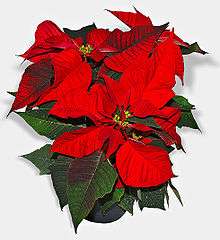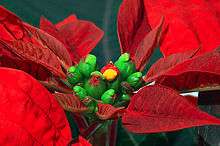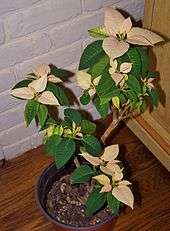Poinsettia
| Poinsettia | |
|---|---|
 | |
| Scientific classification | |
| Kingdom: | Plantae |
| (unranked): | Angiosperms |
| (unranked): | Eudicots |
| (unranked): | Rosids |
| Order: | Malpighiales |
| Family: | Euphorbiaceae |
| Genus: | Euphorbia |
| Species: | E. pulcherrima |
| Binomial name | |
| Euphorbia pulcherrima Willd. ex Klotzsch | |
The poinsettia (/pɔɪnˈsɛtiə/ or /pɔɪnˈsɛtə/)[1][2] (Euphorbia pulcherrima) is a commercially important plant species of the diverse spurge family. The species is indigenous to Mexico. It is particularly well known for its red and green foliage and is widely used in Christmas floral displays. It derives its common English name from Joel Roberts Poinsett,[3] the first United States Minister to Mexico,[4] who introduced the plant to the US in 1825.
Description
_at_Jayanti%2C_Duars%2C_West_Bengal_W_Picture_443.jpg)
Euphorbia pulcherrima is a shrub or small tree, typically reaching a height of 0.6–4 metres (2 ft 0 in–13 ft 1 in). The plant bears dark green dentate leaves that measure 7–16 centimetres (2.8–6.3 in) in length. The colored bracts—which are most often flaming red but can be orange, pale green, cream, pink, white, or marbled—are often mistaken for flower petals because of their groupings and colors, but are actually leaves. The colors of the bracts are created through photoperiodism, meaning that they require darkness (12 hours at a time for at least five days in a row) to change color. At the same time, the plants require abundant light during the day for the brightest color.[5]
The flowers of the poinsettia are unassuming and do not attract pollinators. They are grouped within small yellow structures found in the center of each leaf bunch, and are called cyathia.
The poinsettia is native to Mexico.[6] It is found in the wild in deciduous tropical forests at moderate elevations from southern Sinaloa down the entire Pacific coast of Mexico to Chiapas and Guatemala. It is also found in the interior in the hot, seasonally dry forests of Guerrero, Oaxaca, and Chiapas.[7] Reports of E. pulcherrima growing in the wild in Nicaragua and Costa Rica have yet to be confirmed by botanists.[8]
There are over 100 cultivated varieties of poinsettia.[9][10]
Religious and other traditional associations
The Aztecs used the plant to produce red dye and as an antipyretic medication.[10] In Nahuatl, the language of the Aztecs, the plant is called Cuetlaxochitl, meaning "flower that grows in residues."[10] Today it is known in Mexico and Guatemala as Flor de Noche Buena, meaning Christmas Eve Flower.[10] In Spain it is known as Flor de Pascua or Pascua, meaning Easter flower.[10] In Chile and Peru, the plant became known as Crown of the Andes.[10] In Turkey, it is called Atatürk's flower because Atatürk, the founder of the Republic, liked this flower and made a significant contribution to its cultivation in Turkey.
The plant's association with Christmas began in 16th-century Mexico, where legend tells of a girl, commonly called Pepita or Maria, who was too poor to provide a gift for the celebration of Jesus' birthday and was inspired by an angel to gather weeds from the roadside and place them in front of the church altar.[11] Crimson blossoms sprouted from the weeds and became beautiful poinsettias.[12] From the 17th century, Franciscan friars in Mexico included the plants in their Christmas celebrations.[13] The star-shaped leaf pattern is said to symbolize the Star of Bethlehem, and the red color represents the blood sacrifice through the crucifixion of Jesus.[14]
Poinsettias are popular Christmas decorations[3] in homes, churches, offices, and elsewhere across North America. They are available in large numbers from grocery, drug, and hardware stores. In the United States, December 12 is National Poinsettia Day.[15]
Creation of the American poinsettia industry
Albert Ecke emigrated from Germany to Los Angeles in 1900, opening a dairy and orchard in the Eagle Rock area. He became intrigued by the plant and sold them from street stands. His son, Paul Ecke, developed the grafting technique, but it was the third generation of Eckes, Paul Ecke Jr., who was responsible for advancing the association between the plant and Christmas.[16] Besides changing the market from mature plants shipped by rail to cuttings sent by air, he sent free plants to television stations for them to display on air from Thanksgiving to Christmas. He also appeared on television programs like The Tonight Show and Bob Hope's Christmas specials to promote the plants.[16]
Until the 1990s, the Ecke family, who had moved their operation to Encinitas, California, in 1923, had a virtual monopoly on poinsettias owing to a technique that made their plants much more attractive.[17] They produced a fuller, more compact plant by grafting two varieties of poinsettia together. A poinsettia left to grow on its own will naturally take an open, somewhat weedy look. The Eckes' technique made it possible to get every seedling to branch, resulting in a bushier plant.[17]
In 1991, a university researcher discovered the method previously known only to the Eckes and published it, allowing competitors to flourish, particularly those using low-cost labor in Latin America. The Ecke family's business, now led by Paul Ecke III, decided to stop producing plants in the U.S., but as of 2008, they still serve about 70 percent of the domestic market and 50 percent of the worldwide market.[16]
Cultivation

In areas outside its natural environment, it is commonly grown as an indoor plant where it prefers good morning sun, then shade in the hotter part of the day. Contrary to popular belief, flowering poinsettia can be kept outside, even during winter, as long as it is kept frost-free. It is widely grown and very popular in subtropical climates such as Australia, Rwanda and Malta.
The poinsettia has also been cultivated in Egypt since the 1860s, when it was brought from Mexico during the Egyptian campaign. It is called Bent El Consul, "the consul's daughter", referring to the U.S. ambassador Joel Poinsett.[8]

The plant requires a daily period of uninterrupted long, dark nights followed by bright sunny days for around two months in autumn in order to encourage it to develop colored bracts. Any incidental light during these nights (from a nearby television set, from under a door frame, even from passing cars or street lights) hampers bract production. Commercial production of poinsettia has been done by placing them inside a greenhouse and covering the latter completely to imitate the natural biological situation.
To produce extra axillary buds that are necessary for plants containing multiple flowers, a phytoplasma infection—whose symptoms include the proliferation of axillary buds—is used.[18] The discovery of the role phytoplasmas play in the growth of axillary buds is credited to Ing-Ming Lee of the USDA Agricultural Research Service.[19]
Diseases
Poinsettias are susceptible to several diseases, mostly fungal, but also bacterial and parasitic.
Toxicity claims
In the United States and perhaps elsewhere, there is a common misconception that the poinsettia is highly toxic. This misconception was spread by a 1919 urban legend of a two-year-old child dying after consuming a poinsettia leaf.[20]
While the sap and latex of many plants of the spurge genus are indeed toxic,[21] the poinsettia's toxicity is relatively mild. Its latex can cause an allergic reaction in sensitive individuals.[22] It is also mildly irritating to the skin or stomach[6] and may sometimes cause diarrhea and vomiting if eaten.[23] Sap introduced into the human eye may cause temporary blindness.[24] An American Journal of Emergency Medicine study of 22,793 cases reported to the American Association of Poison Control Centers showed no fatalities, and furthermore that a strong majority of poinsettia exposures are accidental, involve children, and usually do not result in any type of medical treatment.[25] POISINDEX, a major source for poison control centers, says a 50-pound (23 kg) child would have to eat 500 bracts to accumulate levels of toxins found to be harmful in experiments.[20] An Ohio State University study showed no problems even with extremely large doses.[26]
References
- ↑ Wells, John C. (1990). Longman Pronunciation Dictionary. Harlow, England: Longman. ISBN 0-582-05383-8. entry "poinsettia"
- ↑ "poinsettia". Dictionary.com. Retrieved December 15, 2012.
- 1 2 Bussell, Gene (December 2009). "Get Ready for Holiday Flowers". Southern Living. 44 (12): 88.
- ↑ "Mexico". United States Department of State. Archived from the original on November 30, 2009. Retrieved February 17, 2016.
- ↑ "How To Make Poinsettia Turn Red: Make A Poinsettia Rebloom". Gardening Know How. Retrieved January 28, 2010.
- 1 2 Bender, Steve, ed. (January 2004). "Euphorbia". The Southern Living Garden Book (2nd ed.). Birmingham, Alabama: Oxmoor House. p. 306. ISBN 0-376-03910-8.
- ↑ Trejo, L., M. E. Olson, P. Feria, K. M. Olsen, L. E. Eguiarte, B. Arroyo y J. A. Gruhn. 2012. "Poinsettia's wild ancestor in the Mexican dry tropics: historical, genetic, and environmental evidence." American Journal of Botany 99: 1146–1157.
- 1 2 Joel Roberts Poinsett. Columbia Electronic Encyclopedia, 6th Edition [serial online]. November 2011;:1. Available from: Academic Search Complete, Ipswich, MA. Accessed November 8, 2012
- ↑ Perry, Leonard. "Fun Facts About Poinsettia". Perry's Perennial Pages. University of Vermont Extension, Department of Plant and Soil Sciences. Retrieved May 7, 2014.
- 1 2 3 4 5 6 Seltzer, Erica D.; Spinner, MaryAnne. "Poinsettia Facts". The Poinsettia Pages. University of Illinois Extension. Retrieved December 22, 2014.
- ↑ "The Legends and Traditions of Holiday Plants | Horticulture and Home Pest News". www.ipm.iastate.edu. Retrieved 2016-02-17.
- ↑ Flowers Ireland Archived November 18, 2007, at the Wayback Machine.
- ↑ The Legends and Traditions of Holiday Plants | Horticulture and Home Pest News
- ↑ "'The Christmas Poinsettia' Fine Art Print by Anne Gitto". RedBubble. Retrieved January 28, 2010.
- ↑ Poinsettia Day Bill of Congress
- 1 2 3 Anton, Mike (December 23, 2008). "The bloom is off the poinsettia business". Los Angeles Times. Retrieved December 28, 2008.
- 1 2 Cynthia Crossen, "Holiday's Ubiquitous Houseplant," Wall Street Journal, December 19, 2000.
- ↑ Lee; et al. (1997). "Phytoplasma induced free branching in commercial cultivars". 15. Nature Biotechnology: 178–182.
- ↑ http://blogs.usda.gov/2015/12/01/poinsettias-helping-an-icon-to-bloom-at-the-right-time/#more-62176
- 1 2 "Poisonous Poinsettias". Snopes.com. Retrieved December 16, 2008.
- ↑ Tom Eke, Sahar Al-Husainy & Mathew K. Raynor (2000). "The spectrum of ocular inflammation caused by Euphorbia plant sap" (PDF). Arch Ophthalmol. 118 (1): 13–16. doi:10.1001/archopht.118.1.13. PMID 10636407.
- ↑ "Latex Allergy? Beware Poinsettias". WebMD. Retrieved January 28, 2010.
- ↑ "Are Poinsettia Plants Poisonous? Fact or Fiction?". Retrieved December 21, 2007.
- ↑ "Complete Poinsettia information from Drugs.com". Drugs.com. Retrieved November 29, 2008.
- ↑ Krenzelok EP, Jacobsen TD, Aronis JM (November 1996). "Poinsettia exposures have good outcomes...just as we thought". Am J Emerg Med. 14 (7): 671–4. doi:10.1016/S0735-6757(96)90086-8. PMID 8906768.
- ↑ "Poinsettia Care in the Home". Archived from the original on June 7, 2011. Retrieved January 28, 2010.
External links
| The Wikibook Horticulture has a page on the topic of: Euphorbia pulcherrima |
| Wikimedia Commons has media related to Euphorbia pulcherrima. |
| Wikisource has the text of the 1911 Encyclopædia Britannica article Poinsettia. |
- The Wild Poinsettia Page: Images of Euphorbia pulcherrima in the wild in Mexico
- Euphorbia pulcherrima (poinsettia) - Plants & Fungi At Kew
- Patently Poinsettia By Elizabeth Dougherty
- Snopes on toxicity
- Earthworm Castings as a Substrate for Poinsettia Production
- Manipulation of Light Environment to Produce High-quality Poinsettia Plants
- Patent US4724276 - Process for altering poinsettia growth
- Poinsettia: The Christmas Flower
- USDA PLANTS Database, Symbol EUPU9, E. pulcherrima Willd. ex Klotzsch
- Poinsettia pages at the University of Illinois, UIUC
- Poinsettias in Africa
- Ohio State University Fact Sheet
- Poinsettia FAQ